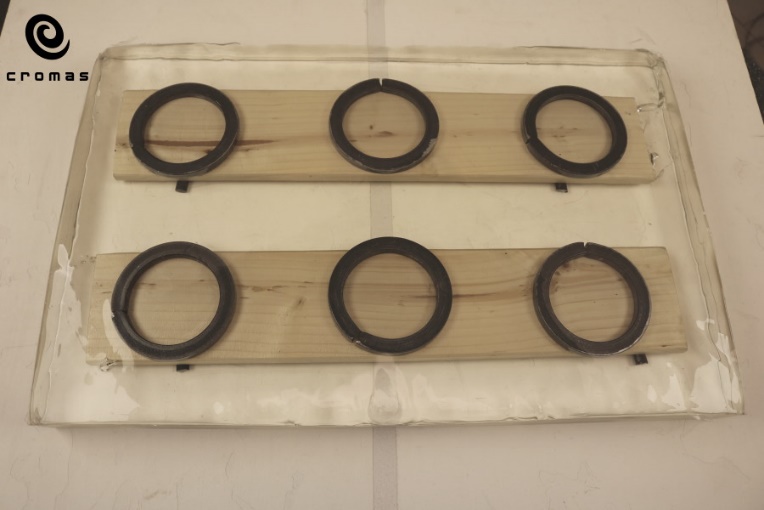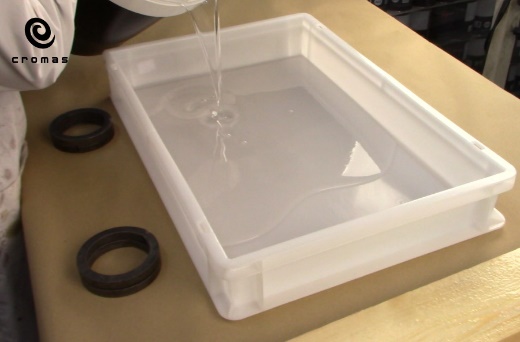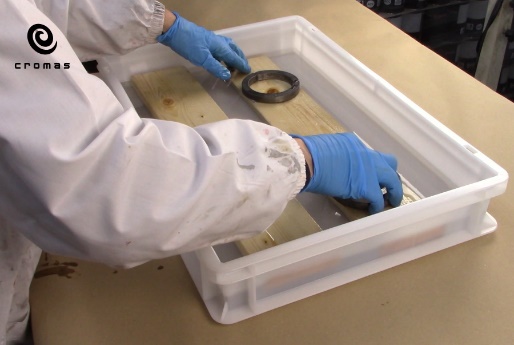
Castings from 4 cm to 10 cm in thickness. Suitable for encased objects, low heat reaction during curing. Developed for professionals and manufacturers
Unlike the application of a low or medium thickness resin, the high thickness (4-10 cm) clear epoxy resin achieves a greater depth for morevisualimpact compared to the low thickness resin.
Once fully cured, this product show lowyellowing because the raw materials have good UV resistance. Surfaces treated with this type of resin are suitable for outdoor use.
With Cromas Paints scientific experience in producing special effect paints, we have developed our resins for professional applications. Many other resins are intended for a DIY customer.
The Cromas resins werescientifically developed to feature these professional characteristics:
- A Low Viscosity and isBalanced – the material is self-leveling at low thickness
- A high resistance to Carbonation – the reaction of the resin hardener with the air and humidity that can cause defects in the surface
- Resistant to UV rays and is Low Yellowing – it is suitable for outdoor use
- Calculated Mass Effect – the temperature rise of the curing resin – tested on common furniture surfaces
- The durability of the cured resin allows for sanding and polishing of the surface

High transparency epoxy resin, for high thickness with encased objects
Crystal clear epoxy resin, for high thickness with encased objects
High transparency epoxy resin for high thickness with wood
High transparency epoxy resin for high thickness with wood
High thickness epoxy resin mold with encased metallic object
High thickness casting epoxy resin with inserted metallic objectsGiven the low temperature rise of this resin, it is possible to insert various sealed materials and to have a higher thickness, unlike low and medium thickness epoxy resins. It is important that during working time, the environment is not cold.
General and important information about resins application technique
Once the resin is fully hardened it becomes a unique glossy surface that is more durable and features a higher resistance than common lacquers due to the thickness. A frame or silicone mold is needed to hold and shape the resin while pouring. The mix has a low viscosity so the air bubbles can evaporate. The cured resin is then removed from the mold when dry.

Blending of epoxy resin before pouring
Mixing of epoxy resin before pouring
How to pour epoxy resin into a high thickness casting
How to pour epoxy resin into a high thickness mold
How to insert items into high thickness epoxy resin
How to encase items into high thickness epoxy resin
Final layer of high thickness epoxy resin with encased objects
Final layer of epoxy resin for high thickness encapsulationsAfter the high thickness resin has fully hardened, it can be polished just like any common lacquered acrylic, polyurethane or polyester material. When polishing, it is important not to heat the resin surface too much with the polishing machine. An excessive amount of heat from polishing can lead to atemporary softening of the suface, and making it harder to polish. This problem can be solved through the application of clear acrylic after sanding with a 500/1000 grit sandpaper.
For applications with inserted objects such as untreatedwood with open pores, it is necessary to seal or insulate the material first. As an alternative to common insulating products, apply 1 or 2 layers of epoxy insulating resin or sealer to achieve excellent results. Best results are obtained by using a high-viscosity insulating product (specifically studied by Cromas) applied with a brush or spatula.
The low thickness resins were designed for pouring on flat surfaces like standalone casting projects. These are called self-leveling resins. When pouring this resin, it is important that the surface is level so the resin thickness is equal in all parts of the surface.
The medium thickness resin applications commonly have a cure time of 24-48 hours at a temperature of 20-25°C. Given the low temperature rise of this resin, we advice to keep the room temperature at 25°C during working time. This is to avoid imperfections and cause an increased curing time. This is true when working with total mass under 5 kg. We advice against using a medium thickness resins for low thickness project because the curing time will be longer and the surface will not be uniform.
Given the high thickness of the application, the temperature rise during curing or Mass Effect must be kept under control as they determine the finish quality. For encased materials that are porous and may contain water or humidity – if the material is not well sealed or insulated – the wood material can create air bubbles from the heat of the curing resin.

Checking temperature of epoxy resin during pouring
Checking temperature of epoxy resin during pouring
Air bubbles due to not sealed wood
Air bubbles because wood is not sealedThis resin can incorporate any material as long as the surface is properly insulated or sealed so that no air, water or humidity can escape. Even wood and metallic materials – usually they are harder to work with – can be encapsulated without problems in this type of resin.
♦ We suggest to read the following page:
Epoxy resin castings with air bubbles – details
In winter, the application process of the resins must be carried out in a warm work environment. The recommended temperature during the curing or hardening time is at least 20° C. At lower temperatures, the curing time increases and some imperfections may appear on the surface. The recommended temperature during working time is 25°-30°C and the temperature should remain the same during the hardening time. It is advised not to store the resin in a cold area during winter.
It is also suggested that the surface material, the encased items, and the working environment not be too humid. This is because too much moisture in the air or in the encased items can react with the mixture and cause defects. In order to assure the resin has good resistance to Carbonation, it is important that the working environment and items to be encased are moisture free.
The importance of the execution of pre production testing
The application process of casting, self-leveling, or encasing objects in epoxy resins is not difficult, but our experience tells us that it is necessary to proceed with testing, to develop your standardized application process especially if there is no previous experience in resins. Cromas Paints goal is to give you the most useful information so your projects are successful. The provided information comes from our direct experience. Because there are many factors to consider, we always advise to proceed with product testing in a controlled working environment and using the same materials.
Related products
-
![front image - Phosphorescent Epoxy Resin]()
Phosphorescent Epoxy Resin
![back image - Phosphorescent Epoxy Resin]()
Phosphorescent Epoxy Resin
-
![front image - Epoxy resin for three-dimensional decorations]()
Epoxy resin for three-dimensional decorations
![back image - Epoxy resin for three-dimensional decorations]()
Epoxy resin for three-dimensional decorations
-
![front image - Transparent coloured epoxy resins]()
Transparent coloured epoxy resins
![back image - Transparent coloured epoxy resins]()
Transparent coloured epoxy resins
-
![front image - Pure Metal metallic epoxy resins]()
Pure Metal metallic epoxy resins
![back image - Pure Metal metallic epoxy resins]()
Pure Metal metallic epoxy resins
-
![front image - Low thickness casting epoxy resins]()
Low thickness casting epoxy resins
![back image - Low thickness casting epoxy resins]()
Low thickness casting epoxy resins





